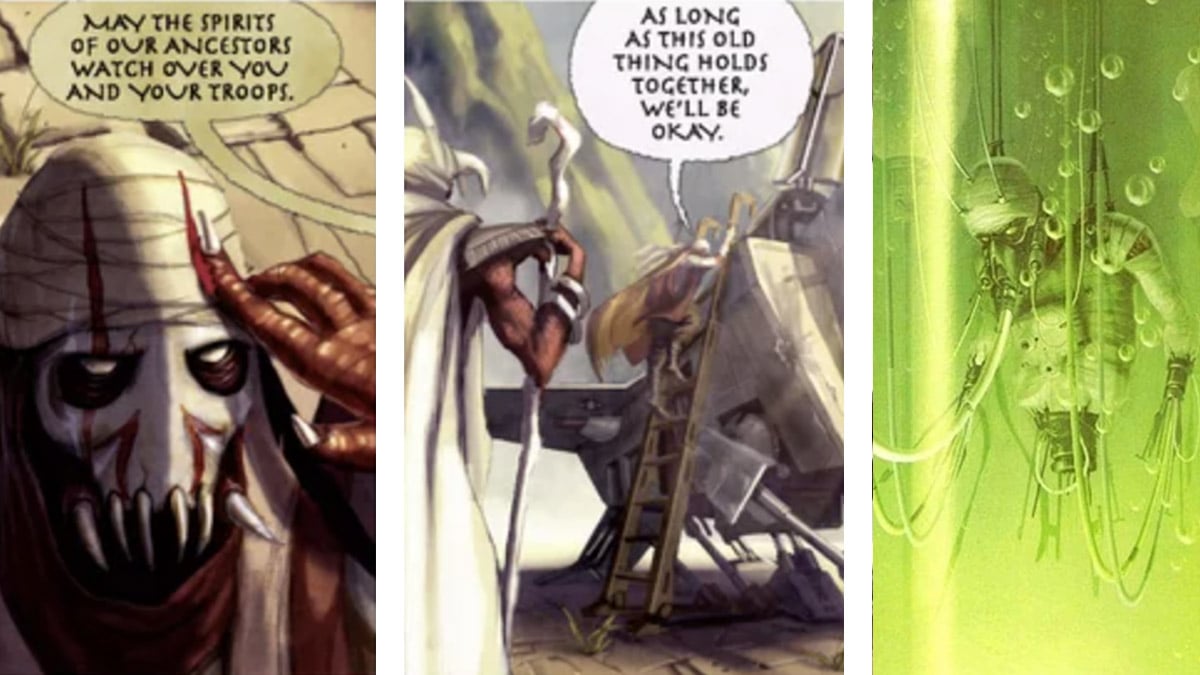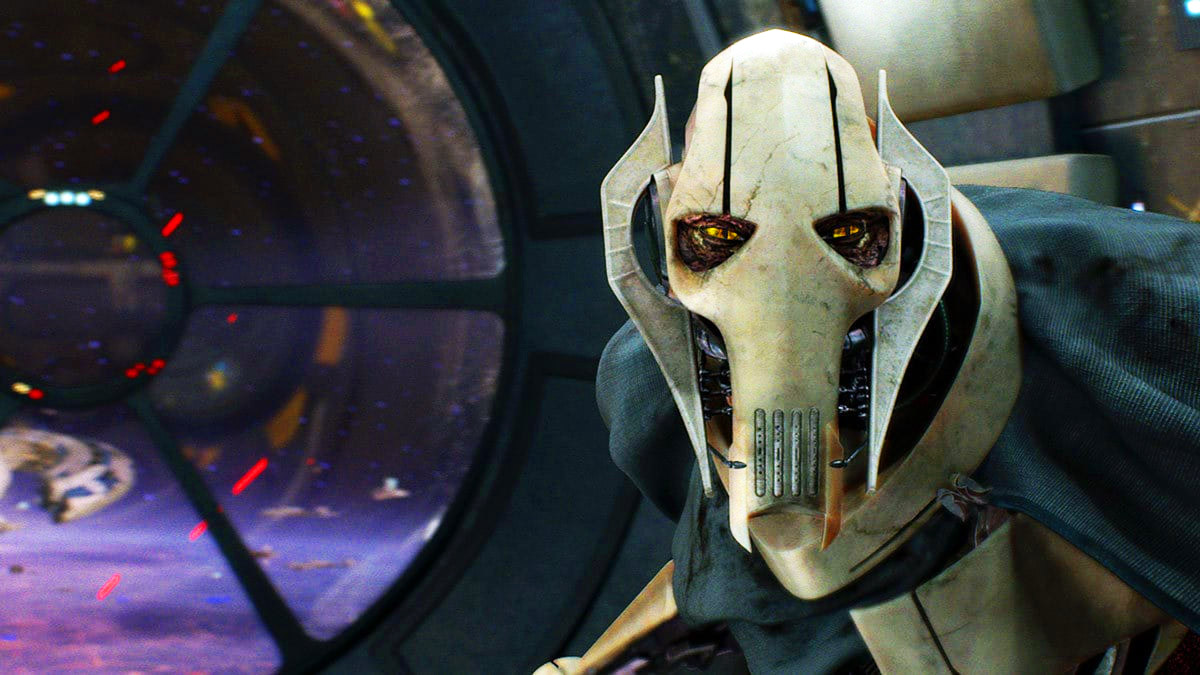A huge part of Star Wars‘ success was the cybernetic villain who strode out of blaster smoke on the Tantive IV in 1977. The extent of Anakin Skywalker’s destruction and emergence as the cybernetically enhanced Darth Vader took decades to unveil.
As Skywalker fell in 2005’s Star Wars: Episode III – Revenge of the Sith, we met another fearsome cyborg who’s a chronological precursor to Vader. Durable and agile, General Grievous looked like a maxed-up shadow of the Sith Lord and unlikely to match his reputation. But the years and extended media following Grievous’ film appearances have secured him a place as one of the saga’s iconic villains. He’s a fascinating bad guy, a superb tactician, and a warrior packed full of contradictions, with an origin that ties into Jedi and Sith knowledge, motivation, and lore.
Grievous appeared at the start of the final movie of the Prequel Trilogy, confronted by Obi-Wan Kenobi, who had been tasked with tracking down the head of the Separatist Army at the end of the Clone Wars. Grievous was a phenomenal opponent for the Jedi, although, in hindsight, he deserved better. Dropping his traditional cloak, the general revealed his almost entirely mechanical frame, with super-fast reflexes and four arms that wielded the lightsabers of the Jedi he’d defeated. Those and his persistent cough were all thanks to his conversion.
His story would be developed through The Clone Wars series, where his increased air time earned cult appeal. Expanded media filled in his background, but, as usual with Star Wars, not all of that is considered canon, and some of it has been adapted and altered over the past 20 years.
Starting as a warlord

Grievous was originally Qymaen jai Sheelal, a warlord of the reptilian Kaleesh. It was on his planet Kalee in the lawless and mostly unmapped Wild Space that he developed a formidable reputation leading his people against the invading Yam’rii of Huk. The invaders were technologically advanced, rooting a suspicion of technology in the warlord as his brutality grew.
As word of his prowess and tactical abilities spread, he took his battle to the stars and assumed the name Grievous. Pushing the invaders away from his planet, the Galactic Republic and Jedi Order intervened to assist the Yam’rii in the face of Grievous’ brutality, something the future general wouldn’t forget.
Meanwhile, Grievous’ power, abilities, and force of will attracted the attention of Darth Sidious and his apprentice Darth Tyrannus, the fallen Jedi Count Dooku. They recognized those admirable Sith qualities in the warlord, despite his lack of Force sensitivity.
Rising to Grievous
The core canon and Star Wars Legend don’t quite agree on the radical transformation that followed Grievous’ rise in reputation and arrival on the radars of both Jedi and Sith.
In the extended non-canonical universe, Grievous’ hatred of the Jedi stemmed from their intervention and treatment of his people. After the knights pushed the Kaleesh back to their planet, Republic sanctions reduced it to poverty and starvation. This was used by Count Dooku, who plotted to break Grievous to serve his and Sidious’ plans better. He arranged the sabotage of Grievous’ shuttle as the warlord resumed his hostility against the Huq, critically injuring the former warlord. Blaming the Jedi for the attack, Dooku had Grievous radically reconstructed as a cyborg. Much of this comes from an epic arc in the Dark Horse comic called The Eyes of Revolution, written by Warren Fu, who designed the villain for the screen.
The Clone Wars would later modify this story, presenting Grievous’ transformation as a reaction to rejection that the Sith exploited. In this version, Grievous had sought to join the Jedi but had been denied as he lacked any Force ability. In a rage, Grievous willingly submitted himself to cybernetic augmentation to increase his reflexes and abilities to rival the Force-enhanced Jedi. In The Clone Wars, he emphatically refers to his enhancements as improvements.
Whether the cause was Jedi rejection or Sith interference, the result was the same — extreme Jedi hatred bottled up in a powerfully reconstructed body the Sith could manipulate. Little remained of Qymaen jai Sheelal beyond his eyes, spinal column, and altered brain — quite possibly fine-tuned to further enhance his speed, hatred, and compliance without his knowledge. Dooku supplemented him with the Midichlorian-packed blood of the powerful slaughtered Jedi Sifo-Dyas, which, while not granting any Force powers, kept Grievous alive and attuned him to learning Jedi skills.
The general’s core organs remained, too (seen in quite miserable detail in his final fight with Obi-Wan Kenobi). It was an enhancement to his lungs that gave him his distinctive cough. That’s considered to be a compatibility issue, with his organs rejecting the modification. It’s something the Sith would learn from for the next time they funded the cybernetic reconstruction of a disciple. Grievous’s voice was a synthetic reproduction of his original, and he retained the face of his warlord mask and continued wearing the cape of his people.
Entering the Clone Wars
Any reservations about taking a pivotal role in establishing a New Order were banished when San Hill, Chairman of the InterGalactic Banking Clan who supported the Confederacy of Independent Systems, bribed him by providing financial support to his home planet.
Joining the Confederacy, Grievous was soon only second in the Separatist Alliance to Dooku as the Clone Wars kicked off. His ability with a lightsaber or four was an essential part of his success. These skills and knowledge of Jedi arts were taught to him by Dooku and his MagnaGuards. Dooku gifted Grievous his first lightsaber, formerly of Sifo-Dyas. The cyborg’s saber skills improved along with his continued robotic enhancements, and he established a reputation as a Jedi hunter, seizing the lightsabers from his defeated opponents as trophies. Grievous had been radically altered and manipulated, but his primary weapon remained — spreading fear throughout the galaxy.
Grievous had become one of the most significant leaders the galaxy had ever seen, but increasingly a lone figure who made organics and droids uncomfortable. He treated his droid armies with utter contempt, unwilling to accept any connection considering he was almost completely robotic. Waking to realize the extent of his cybernetic transformation, Grievous slaughtered a host of MagnaGuard in rage.
Despite that hatred of droids, the general rose to lead the Separatist Army because his hatred of the Jedi was greater. If he seems a bit different in the 2003 Clone Wars cartoon, it’s because the character was still being developed for Episode III, eventually emerging as a bit more of a one-dimensional meme-spouting villain. His appearances in the expanded animated series, The Clone Wars, helped to redeem him as a fascinating villain.
Unsurprisingly, a live-action adaptation of his early years remains high on the wish list of many Star Wars fans. Every intricate and devastating cyborg who appears in the franchise now lives in the multi-limbed shadow of Grievous. However, that legacy owes a lot to the saga’s origins. The general’s threat is rooted in his past while sharing many links and some crucially important pathos with Darth Vader.

